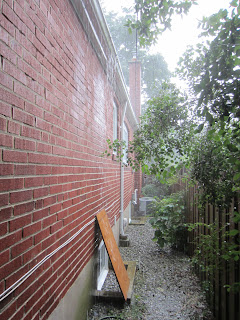With so many heavy rains this summer in Toronto, basement flooding has become an epidemic. The rains have spurred so many desperate calls to our office that we have trouble keeping up!. Chances are it involves an overflowing eavestrough and a window well. We can feel their pain of having to shop vac carpets and damage to walls etc.
This unfortunately is a reminder to homeowners who have neglected to keep up with the maintenance of critical things like eavestroughs and grading around the home.
Panic calls are usually the result of just a few factors:
1. The most frequent is eavestroughs and or downspouts plugged solid with leaves. This is the main factor with the majority of calls. If you have trees you need to have them cleaned frequently. When we say frequently we mean up to 3 or 4 times a year if you have no leaf guard. It takes just a handful of leaves to plug the top of a downspout. Having no leaf guard will greatly increase your maintenance. And since you usually cannot see in the eavestrough, you will always be wondering is that eavestrough plugged or not? This is too stressful if an overflowing eavestrough will result in your basement leaking. With heavy rains maximizing the capacity of your system, a small amount of debris can shut things down and cause a major overflow.
Solution: Clean and inspect your eavestroughs with the forecast of each rain OR have some peace of mind and invest in a good leaf guard, clean and inspect yearly if needed and get some sleep.
2. Murphy's Law will come into play here as usually an overflowing leaf filled eavestrough will dump water directly into a window well. Time this with a 2 am rainstorm and you will be wishing you bought a condo. The window well may or may not have the proper drainage to evacuate the water fast enough to keep the water from building up and running in the windows.
Solution: Refer to the solution in number one and also have proper drains in the bottom of the window wells with the addition of a plastic window well cover to deflect water away.
3. Old poorly sloped eavestrough that hold water, get heavy and surrender to gravity. Eavestroughs sloped incorrectly will hold water and cause the old outdated system of nailing the eavestroughs to the house to come loose letting a river of water to flow beside your home.
Tip: If your eavestroughs are sloped correctly and your downspout plugs with leaves, the eavestrough overflow will be near the downspout. If the eavestrough always overflows 20 or 30 feet away or more then that is telling you that the low point in your eavestrough is not at the downspout, where it should be and you may need to fix your angles.
Solution: Correct slopes if your eavestroughs are newer. If older, say 20 or 30 years old it's best to replace with new. Why spend a bunch of money on an old eavestrough that's at the end of its life span? Install with a fastening system that is screwed directly to your home. The big old nails holding some eavestroughs on are susceptible to coming loose.
4. Poorly located downpipes drain water into an area that stays near your home. This water pools and seeps into the ground along your foundation.
Solution: Redesign the slopes of the eavestroughs and choose a better location for the downpipe. If possible, a simple solution is to add a long downpipe extension at the bottom elbow to get out of a low spot and safely to an area where the water will drain away from the foundation.
5. Downspouts connected to city drains. The city system is overwhelmed during a storm so adding more water from your roof into the mix can cause water to back up drains into your basement. Also many pipes are made of clay and deteriorate over time. Who had the brainwave to make very important drains around your home out of clay anyway? The good thing is no one uses clay pipes anymore. If you have a basement leak near a clay downpipe, then you have every reason to be very suspicious of it.
Solution: Every home is unique, but if possible disconnect or relocate downpipes to other locations and let them safely drain water away from the foundation. If impossible, then you may have to dig up the pipe or inspect with a camera to get to the root cause (plumbers have these).
6. Downspout disconnected from city drains. This seems to contradict number 5 but I will explain. It's great so many homeowners want to conform to the new City of Toronto deadlines of disconnecting downpipes but if done in haste, it can come back to haunt you. First off, everyone should know that not every downspout should be disconnected as not every home has the drainage to accomplish this. Disconnecting a downspout and letting water pour against your home or your neighbors home is bad news. Speaking of neighbours, if your roof water is flowing under the fence, it may fly under the radar until they get water problems. Then you can bet they will be peering over the fence with disgust at that downspout pointing at their home. There are bylaws here in Toronto that require you to contain your rainwater on your own property. Plus, it's just the neighbourly thing to do.
Solution: Remain connected to city drains and apply for an exemption with Toronto water. The other possible solution is to redesign your eavestroughs so the downspouts are in different locations than they are now.
Live in North York, Scarborough or another area in or near Toronto? For a free estimate on replacing your eavestrough system check out North Shore Eavestroughing at www.eavestrough.ca Call us at 416.615.0443





No comments:
Post a Comment